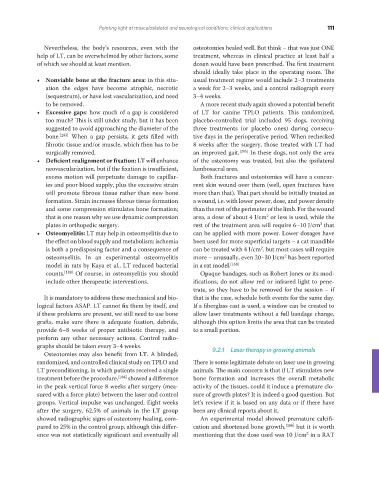Page 125 - Veterinary Laser Therapy in Small Animal Practice
P. 125
Pointing light at musculoskeletal and neurological conditions: clinical applications 111
Nevertheless, the body’s resources, even with the osteotomies healed well. But think – that was just ONE
help of LT, can be overwhelmed by other factors, some treatment, whereas in clinical practice at least half a
of which we should at least mention. dozen would have been prescribed. The first treatment
should ideally take place in the operating room. The
• Nonviable bone at the fracture area: in this situ- usual treatment regime would include 2–3 treatments
ation the edges have become atrophic, necrotic a week for 2–3 weeks, and a control radiograph every
(sequestrum), or have lost vascularization, and need 3–4 weeks.
to be removed. A more recent study again showed a potential benefit
• Excessive gaps: how much of a gap is considered of LT for canine TPLO patients. This randomized,
too much? This is still under study, but it has been placebo-controlled trial included 95 dogs, receiving
suggested to avoid approaching the diameter of the three treatments (or placebo ones) during consecu-
bone. [283] When a gap persists, it gets filled with tive days in the perioperative period. When rechecked
fibrotic tissue and/or muscle, which then has to be 8 weeks after the surgery, those treated with LT had
surgically removed. an improved gait. [285] In these dogs, not only the area
• Deficient realignment or fixation: LT will enhance of the osteotomy was treated, but also the ipsilateral
neovascularization, but if the fixation is insufficient, lumbosacral area.
excess motion will perpetuate damage to capillar- Both fractures and osteotomies will have a concur-
ies and poor blood supply, plus the excessive strain rent skin wound over them (well, open fractures have
will promote fibrous tissue rather than new bone more than that). That part should be initially treated as
formation. Strain increases fibrous tissue formation a wound, i.e. with lower power, dose, and power density
and some compression stimulates bone formation; than the rest of the perimeter of the limb. For the wound
that is one reason why we use dynamic compression area, a dose of about 4 J/cm or less is used, while the
2
2
plates in orthopedic surgery. rest of the treatment area will require 6–10 J/cm that
• Osteomyelitis: LT may help in osteomyelitis due to can be applied with more power. Lower dosages have
the effect on blood supply and metabolism; ischemia been used for more superficial targets – a cat mandible
is both a predisposing factor and a consequence of can be treated with 4 J/cm , but most cases will require
2
2
osteomyelitis. In an experimental osteomyelitis more – unusually, even 20–30 J/cm has been reported
model in rats by Kaya et al., LT reduced bacterial in a rat model. [164]
counts. [188] Of course, in osteomyelitis you should Opaque bandages, such as Robert Jones or its mod-
include other therapeutic interventions. ifications, do not allow red or infrared light to pene-
trate, so they have to be removed for the session – if
It is mandatory to address these mechanical and bio- that is the case, schedule both events for the same day.
logical factors ASAP. LT cannot fix them by itself, and If a fiberglass cast is used, a window can be created to
if these problems are present, we still need to use bone allow laser treatments without a full bandage change,
grafts, make sure there is adequate fixation, debride, although this option limits the area that can be treated
provide 6–8 weeks of proper antibiotic therapy, and to a small portion.
perform any other necessary actions. Control radio-
graphs should be taken every 3–4 weeks. 9.2.1 Laser therapy in growing animals
Osteotomies may also benefit from LT. A blinded,
randomized, and controlled clinical study on TPLO and There is some legitimate debate on laser use in growing
LT preconditioning, in which patients received a single animals. The main concern is that if LT stimulates new
treatment before the procedure, [284] showed a difference bone formation and increases the overall metabolic
in the peak vertical force 8 weeks after surgery (mea- activity of the tissues, could it induce a premature clo-
sured with a force plate) between the laser and control sure of growth plates? It is indeed a good question. But
groups. Vertical impulse was unchanged. Eight weeks let’s review if it is based on any data or if there have
after the surgery, 62.5% of animals in the LT group been any clinical reports about it.
showed radiographic signs of osteotomy healing, com- An experimental model showed premature calcifi-
pared to 25% in the control group, although this differ- cation and shortened bone growth, [286] but it is worth
2
ence was not statistically significant and eventually all mentioning that the dose used was 10 J/cm in a RAT
REDONDO PRINT (4-COL BLEED).indd 111 08/08/2019 09:48

